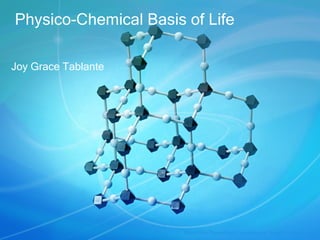Physico chemical basis of life
•
8 gostaram•2,353 visualizações
Denunciar
Compartilhar
Denunciar
Compartilhar

Recomendados
Mais conteúdo relacionado
Mais procurados
Mais procurados (20)
Biology - Chp 2 - The Chemistry Of Life - PowerPoint

Biology - Chp 2 - The Chemistry Of Life - PowerPoint
Semelhante a Physico chemical basis of life
Semelhante a Physico chemical basis of life (20)
Chemical Bases of Life-Chapter Number #30-mcgraw-hill-higher-education, from ...

Chemical Bases of Life-Chapter Number #30-mcgraw-hill-higher-education, from ...
Introduction to Biology Lecture Chapter 2 Study Guide.pdf

Introduction to Biology Lecture Chapter 2 Study Guide.pdf
periodic table of elements power point presentation

periodic table of elements power point presentation
General Biology. LECTURE 2. THE CHEMICAL FOUNDATION OF LIFE.pptx

General Biology. LECTURE 2. THE CHEMICAL FOUNDATION OF LIFE.pptx
Mais de joygtablante
Mais de joygtablante (9)
Último
This presentation was provided by William Mattingly of the Smithsonian Institution, during the fourth segment of the NISO training series "AI & Prompt Design." Session Four: Structured Data and Assistants, was held on April 25, 2024.Mattingly "AI & Prompt Design: Structured Data, Assistants, & RAG"

Mattingly "AI & Prompt Design: Structured Data, Assistants, & RAG"National Information Standards Organization (NISO)
APM Welcome
Tuesday 30 April 2024
APM North West Network Conference, Synergies Across Sectors
Presented by:
Professor Adam Boddison OBE, Chief Executive Officer, APM
Conference overview:
https://www.apm.org.uk/community/apm-north-west-branch-conference/
Content description:
APM welcome from CEO
The main conference objective was to promote the Project Management profession with interaction between project practitioners, APM Corporate members, current project management students, academia and all who have an interest in projects.APM Welcome, APM North West Network Conference, Synergies Across Sectors

APM Welcome, APM North West Network Conference, Synergies Across SectorsAssociation for Project Management
Mehran University Newsletter is a Quarterly Publication from Public Relations OfficeMehran University Newsletter Vol-X, Issue-I, 2024

Mehran University Newsletter Vol-X, Issue-I, 2024Mehran University of Engineering & Technology, Jamshoro
Último (20)
Web & Social Media Analytics Previous Year Question Paper.pdf

Web & Social Media Analytics Previous Year Question Paper.pdf
SECOND SEMESTER TOPIC COVERAGE SY 2023-2024 Trends, Networks, and Critical Th...

SECOND SEMESTER TOPIC COVERAGE SY 2023-2024 Trends, Networks, and Critical Th...
Mattingly "AI & Prompt Design: Structured Data, Assistants, & RAG"

Mattingly "AI & Prompt Design: Structured Data, Assistants, & RAG"
APM Welcome, APM North West Network Conference, Synergies Across Sectors

APM Welcome, APM North West Network Conference, Synergies Across Sectors
Mixin Classes in Odoo 17 How to Extend Models Using Mixin Classes

Mixin Classes in Odoo 17 How to Extend Models Using Mixin Classes
This PowerPoint helps students to consider the concept of infinity.

This PowerPoint helps students to consider the concept of infinity.
Physico chemical basis of life
- 1. Physico-Chemical Basis of Life Joy Grace Tablante More Free PowerPoint Templates at SmileTemplates.com
- 3. Matter Flowchart MATTER Can it be physically separated? Homogeneous Mixture (solution) Heterogeneous Mixture Compound yes no Element MIXTURE PURE SUBSTANCE Can it be chemically decomposed? no yes Is the composition uniform? no yes Colloids Suspensions
- 6. Compounds can either be Inorganic or Organic. These compounds are nutrients which provide energy or materials for all cell activities. Living things are mostly made of organic compounds that contain carbon and hydrogen. Often they contain oxygen too
- 16. Atomic Number
- 20. CATION ANION when Li, Be and Ca loose their electrons the "new" valence electrons in the ion are drawn in. These elemental ions are stable in the sense that they will not readily gain or loose electrons. However, since they are charged they can combine electrostatically to form ionic bonds. the resulting compound is called "ionic" or "salt", e.g., Ca+ + 2Cl- ---> Ca(Cl)2 = calcium chloride. H + : a positively charged hydrogen ion H : the hydrogen atom H - : a negatively charged hydrogen ion
- 21. IONS
- 24. Carbon Isotopes
- 29. How brain function is studied now? PET, CAT, MRI, etc. Music Appreciation Hearing, speaking, seeing, thinking about words
- 60. Acids, Bases and Salts
Notas do Editor
- Calcium: The mineral that strengthens bone and teeth uses calcium. Also important in nerve synaptic transmission of nerve impulses and muscle contraction. Regulates the cell wall construction in plants. Phosphorus: Part of the phosphate groups in ATP and DNA molecules. In plants it is needed for cell reproduction and division. It is part of the cell membrane. Iron: found in the structure of hemoglobin and essential for the production of red blood cells. It is involved in the light energy transferring compounds involved in photosynthesis in plants. Sodium: Major ion associated with the propagation of a nerve impulse. Can replace potassium in some plants. Sulfur: It is a component of amino acids.